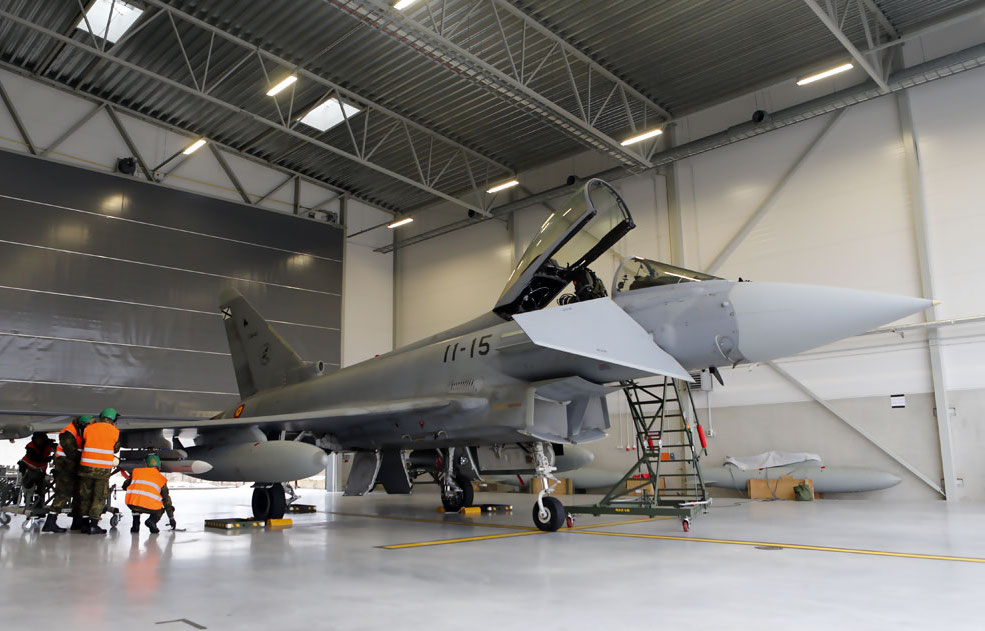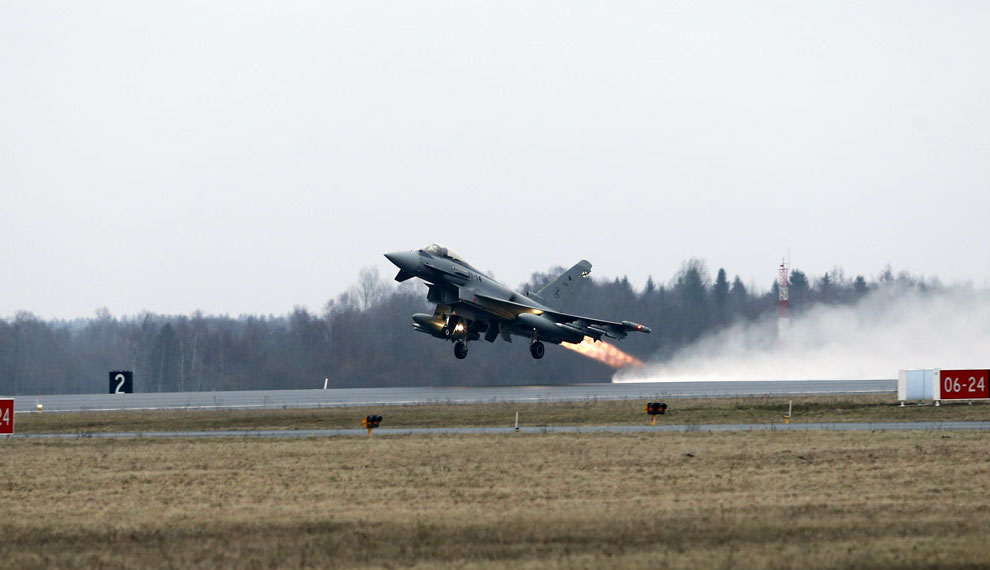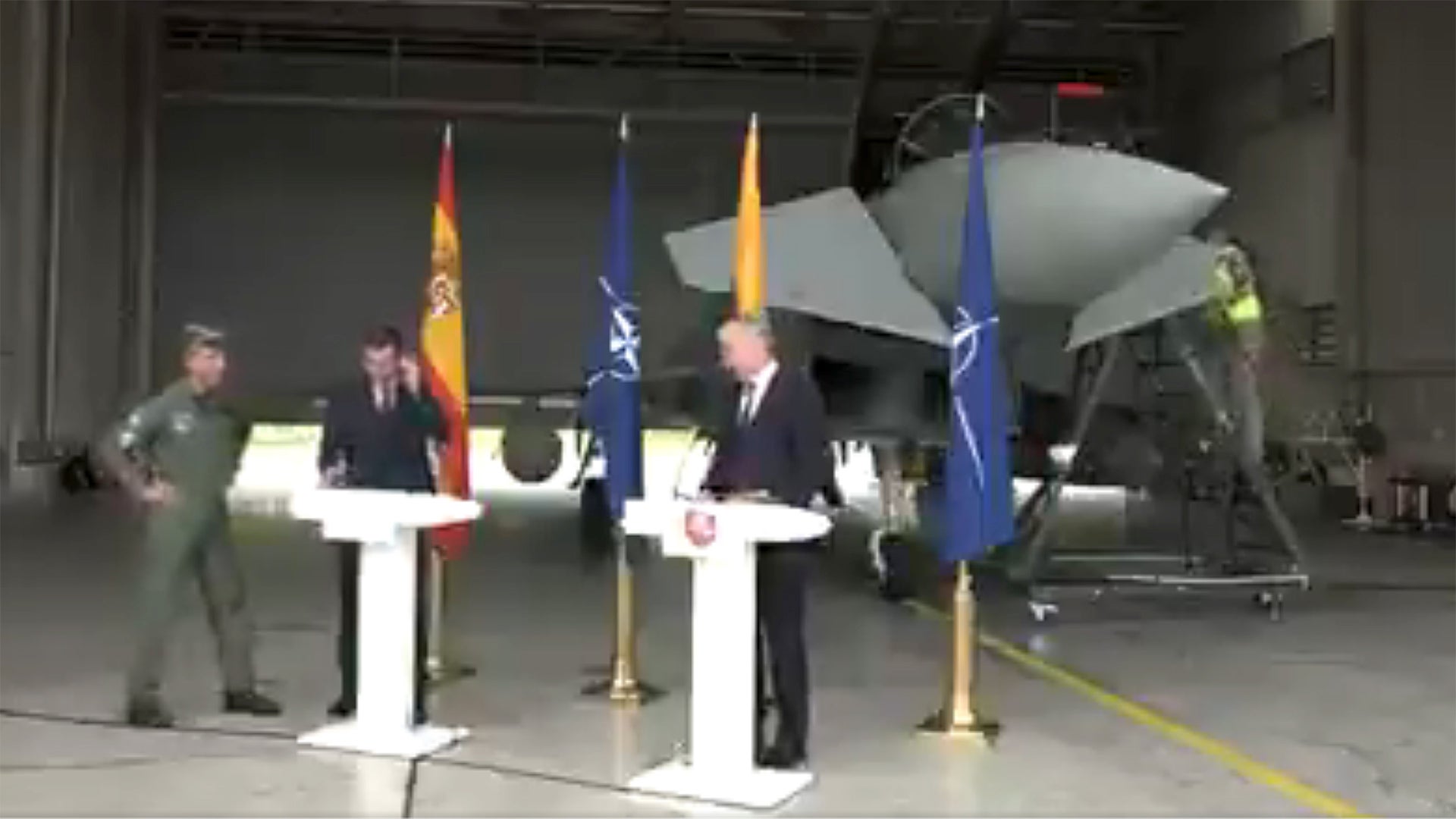A visit to a Lithuanian airbase by Spain’s Prime Minister Pedro Sánchez, and Lithuanian President Gitanas Nauseda was all set to include the two leaders speaking to the press in front of a Spanish Air Force Eurofighter Typhoon jet, deployed to the country on a rotational NATO air policing mission. However, in an impromptu demonstration of the air alert facility’s readiness, Nauseda had to break off his address as the jet was prepared to scramble to intercept Russian aircraft approaching NATO’s Baltic territories.
The press conference was taking place at Šiauliai Air Base, Lithuania, earlier today, as part of the Spanish leader’s three-day visit to the Baltic states, including checking in on the Spanish armed forces contingent deployed as part of the NATO mission to help defend these countries. While Nauseda was speaking in a hangar at Šiauliai, a pilot could be seen racing up the ladder into the Typhoon in the background, while technicians prepared the jet for action. An advisor then explained that a live scramble had begun and the officials and their lecterns began to be moved out of the way to let the jet depart the hangar.

According to Spanish newspaper El Pais, citing unnamed Spanish government sources, the incident was a live, or Alpha, scramble, rather than a training scenario. Two Spanish Typhoons were scrambled, as is the normal procedure, to respond to at least one unidentified Russian aircraft. The fighters taking part in the Baltic Air Policing (BAP) mission routinely intercept Russian military aircraft, to ensure they don’t enter the national airspace of the Baltic states. BAP guidelines state that the NATO fighters, which carry live weapons, have to be airborne within 15 minutes of the alert.


The original planning for the day’s events had included a practice, or Tango scramble, after the leaders’ address, but it seems that wasn’t required.
El Pais reported that unnamed military sources “assume that Russia intentionally raised the alert for the visit of the Spanish leader,” especially since there had been no previous such incidents in the previous 18 days. “Alliance sources believe that it is not by chance that [the alert] occurred during the appearance of Sánchez and the Lithuanian president,” the newspaper added. However, Russian military aircraft activity in the Baltic, and especially between the exclave of Kaliningrad and Russia itself is by no means uncommon.
The press conference reportedly resumed 25 minutes in an empty hangar after the Spanish jets had departed for the live scramble.
The Spanish prime minister took the opportunity to point to the latest alert incident to show “the importance of our presence here.” Similar sentiments were echoed on Twitter by Nauseda, although it should be noted that there is no indication that the Russian aircraft violated NATO airspace at any point.
What is unclear, however, is why the presidential press conference was scheduled to take place in a hangar in front of an alert jet in the first place. Even if this particular Typhoon was not a primary-assigned alert jet, and had to be used as a backup, there seems to have been some kind of oversight in the planning. In the past, at least some BAP alert jets have been kept in a high-security, sanitized area. Although it appears the jets were able to scramble without problem today, Russia, deliberately or otherwise, still managed to effectively upend a high-level press conference.
The fact that an Alpha scramble might occur during the event would likely have been a consideration, at least. After all, the number of NATO scrambles Europe-wide has been on the increase. Across the continent last year there were more than 400 scrambles, around 350 of which were in response to flights by Russian military aircraft. This was a moderate increase compared to 2019, according to NATO. The Baltic, in particular, has long been a hotbed of this kind of activity.

Currently, around 140 personnel from the Spanish military are at Šiauliai for the BAP mission. The Spanish Air Force, or Ejército del Aire, has been providing the latest BAP rotation at the Lithuanian base since April 30, while an Italian Air Force F-35A contingent is meanwhile making its debut appearance at Ämari in Estonia. These are currently augmented by a detachment of Turkish Air Force F-16s at Malbork in Poland.
To date, Spain has been one of the active contributors to BAP, with eight of these deployments to the Baltic since 2006. As well as Typhoons, Spain has also sent Mirage F1M and EF-18 Hornet fighters to the region.

During the 2018 deployment, the Spanish Typhoons made headlines after an AIM-120 Advanced Medium-Range Air-to-Air Missile, or AMRAAM was accidentally fired by one of the jets, around 50 miles west of the country’s border with Russia. That incident was later attributed to pilot error.
The video below shows Spanish Typhoons during the Baltic Air Policing mission in 2016:

Typically, around four fighters are deployed to each BAP base, although the current Spanish contingent in Lithuania, known as Vilkas 2021, is larger than usual, with seven jets, although only four of these have been transferred to the NATO chain of command, the remainder presumably available as spares or for unrelated training sorties.
The BAP mission has been carried out since Latvia, Lithuania, and Estonia joined NATO in 2004, as none of these countries have their own fighter jets. Different NATO rotations provide the Baltic states with the ability to monitor and control their airspace, conducting quick reaction alert (QRA) missions on their behalf.
Most real-world missions involve intercepting and identifying Russian military aircraft that do not comply with international flight regulations, for example flying without transmitting a transponder code to indicate their position and altitude, lack of a proper flight plan, or failure to communicate with air traffic controllers. All of these pose a potential risk to civilian airliners.
In the meantime, it’s very likely that encounters between Russia and NATO in the Baltic region will continue in the days to come, with preparations now well underway for the Navy Day parade in St. Petersburg later this month, which is expected to feature at least three nuclear-powered Russian Navy submarines. Of these, the Borei-A class ballistic missile submarine Knyaz Vladimir and the Oscar II class cruise missile submarine Orel have already entered the Baltic. Also awaited is the Akula II class nuclear-powered attack submarine Vepr.
It’s unclear whether Russia really launched aircraft into the area in order to disrupt the Spanish-Lithuanian meeting today, as has been alleged. However, if that was the intention, the rapid and very public response by the Spanish Air Force contingent shows that the BAP mission continues to work just as advertised — providing 24/7 airspace coverage to the three Baltic states. In the future, however, we might expect to see any press conferences taking place a little further away from the alert jets.
Update, July 9: NATO and the Russian media have confirmed that the aircraft the Spanish Typhoons were scrambled to investigate yesterday comprised a pair of Russian Naval Aviation Su-24 Fencer jets.
Russian state news agency TASS
reports that two Su-24s were conducting a scheduled training flight over the Baltic Sea. Russian defense officials stressed that “the flight was carried out in strict accordance with international rules for the use of airspace, without violating the borders of other states.”
A NATO official speaking anonymously to Associated Press
confirmed that the aircraft investigated by the Typhoons were two Russian Su-24s heading northeast. “Those two Russian jets did not file a flight plan, did not have their flight transponder on, or talk to traffic controllers,” the official added.
Meanwhile, NATO Air Command tweeted that “the Russian aircraft did not follow internationally recognized flight regulations,” and provided two photos of Russian Naval Aviation Su-24s, at least one of which is a Su-24MR Fencer-E reconnaissance version. It’s not clear if these are file photos or whether they were taken during yesterday’s mission.
Contact the author: thomas@thedrive.com
